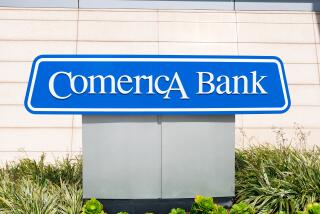U.S. Banks See Rise in Problem Business Loans
- Share via
WASHINGTON — Troubled large loans to corporate borrowers have increased substantially in 2000, with problems persisting in the health-care sector and spreading to other industries, federal bank regulators said Tuesday.
Overall, troubled large loans have risen to $99.6 billion, or 5.1% of the total, up from $68.8 billion, or 3.7%, a year earlier, according to a regulators’ survey.
The survey is the latest warning about risks building in banks’ loan portfolios. Still, experts say bank credit quality remains better than in the early 1990s, when commercial real estate failures, contraction in the defense industry and speculative residential real estate projects caused widespread credit problems for banks.
The large-loan data cover so-called syndicated loans worth $20 million or more. Syndicated loans tend to be to higher-risk corporate borrowers, and are typically spread among three or more banks.
The survey, known as the Shared National Credit Program, is conducted yearly by the comptroller, the Federal Reserve and the Federal Deposit Insurance Corp.
“What we’re seeing is a little broader industry representation” in loan problems, said David Gibbons, deputy comptroller for credit risk at the Comptroller of the Currency, which regulates national banks.
Three sectors had more troubled syndicated loans than average: services, which includes health care, where troubled loans were 8.5% of total credits; wholesale and retail trade, at 6.8%; and manufacturing, at 6.7%.
Three sectors had below-average troubled loans: transportation, communications and utilities, at 3.6% of credits; financial services, at 3.3%; and oil and gas, at 1.8%.
The survey covered 9,848 loans to 5,844 borrowers totaling $1.9 trillion. Of that total, $63.3 billion were classified as having some level of loss, up 69% from $37.4 billion in 1999.
In addition, $36.3 billion were regarded as “special mention”--identified by regulators as potentially weak--up 16% from 1999.
Health care “remains the industry with the highest relative concentration” of these large problem loans, the survey said. Gibbons said long-term care companies and nursing homes were trouble spots, in the wake of Medicare-related funding woes that began in 1998.
But regulators said health-care credits could improve soon because hospitals are charging managed-care insurers higher prices and Congress is expected to raise payments under Medicare.
More to Read
Inside the business of entertainment
The Wide Shot brings you news, analysis and insights on everything from streaming wars to production — and what it all means for the future.
You may occasionally receive promotional content from the Los Angeles Times.










